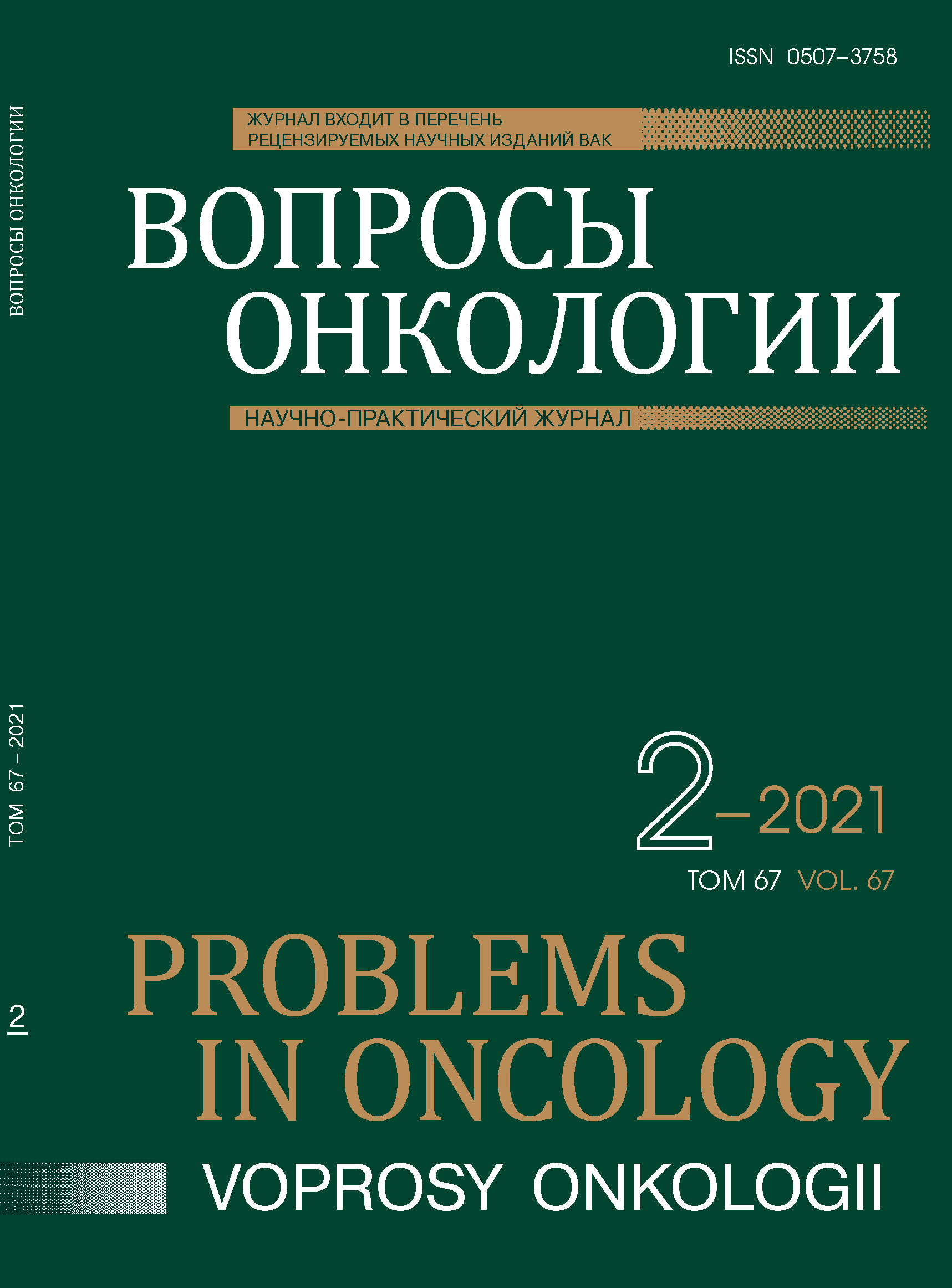摘要
В обзорной статье рассматривается проблема оптимизации лечения злокачественных опухолевых поражений плевры, в том числе сопровождающихся экссудативным плевритом, являющихся свидетельством распространенного опухолевого процесса, сопряженного с невозможностью излечения, и существенного улучшения отдаленных результатов. Показано, что морфологические, иммуногистохимические и молекулярно-генетические особенности опухоли являются важными прогностическими и предиктивными факторами, во многом определяющими и лечебную тактику. Все современные клинические рекомендации однозначно утверждают, что в подавляющем большинстве случаев мероприятия по лечению злокачественных опухолевых плевритов должны носить паллиативный характер. Основной целью у таких больных является уменьшение симптомов и улучшение качества жизни. Бессимптомные экссудативные плевриты не требуют лечения. Торакоцентез или симптоматическое дренирование обеспечивает немедленное улучшение состояния. При невысоком темпе накопления экссудата, редких рецидивах, предполагаемой высокой эффективности противоопухолевого лечения, либо низкой ожидаемой выживаемости можно ограничиться использованием этих процедур. Остальным больным по индивидуальным показаниям рекомендуется минимально инвазивное или хирургическое вмешательство – установка постоянных плевральных катетеров, выполнение различных вариантов плевродеза, эффективность которых достигает 87-96%. Внедрение современных методик проведения плевральных процедур позволило снизить частоту их осложнений до 2,7-4,0%. Несомненно, необходимо продолжать совершенствование существующих алгоритмов и поиск альтернативных решений, в том числе и на основе комплексного применения возможностей современной медицины.
参考
Арсеньев А.И., Нефедов А.О., Левченко Е.В. и соавт. Оптимизация методов лечения хирургических осложнений при раке лёгкого. Вопросы онкологии. 2012; 58(5):674-679.
Левченко Е.В., Мамонтов О.Ю., Сенчик К.Ю. и др. Гипертермическая химиоперфузия плевральной полости в комбинированном лечении злокачественной мезотелиомы плевры. Вопросы онкологии. 2014;4:482-485.
Arrieta O., Escamilla-López I., Lyra-González I. et al. Radical aggressive treatment among non-small cell lung cancer patients with malignant pleural effusion without extra-thoracic disease. J. Thorac. Dis. 2019;11(2):595-601.
Bibby A.C., Dorn P., Psallidas I. et al. ERS/EACTS statement on the management of malignant pleural effusions. Eur. Respir. J. 2018;52: 1800349. https://doi.org/10.1183/13993003.00349-2018.
Brims F.J., Meniawy T.M., Duffus I. et al. A novel clinical prediction model for prognosis in malignant pleural mesothelioma using decision tree analysis. J. Thorac. Oncol. 2016; 11: 573-582.
Chen J., Li Z., Xu N. et al. Efficacy of medical thoracoscopic talc pleurodesis in malignant pleural effusion caused by different types of tumors and different pathological classifications of lung cancer. Int. J. Clin. Exp. Med. 2015; 8(10):18945–18953.
Chiang C.L., Wang L.C., Ho H.L. et al. Effect of postoperative systemic therapy on pulmonary adenocarcinoma with unexpected pleural spread detected during thoracotomy or thoracoscopy. Oncotarget. 2017; 9(4):5435-5444.
Clive A.O.J., Bhatnagar R., Preston N.J. et al. Interventions for the management of malignant pleural effusions: a network meta-analysis. Cochrane Database Syst. Rev. 2016; 5:CD010529.
Dai C., Ren Y., Xie D. et al. Does lymph node metastasis have a negative prognostic impact in patients with NSCLC and M1a disease? J. Thorac. Oncol. 2016;11(10):1745-1754.
Davies H.E., Mishra E.K., Kahan B.C. et al. Effect of an indwelling pleural catheter vs chest tube and talc pleurodesis for relieving dyspnea in patients with malignant pleural effusion: the TIME2 randomized controlled trial. JAMA. 2012;307: 2383-2389.
Feller-Kopman D.J., Reddy C.B. et al. On behalf of the American Thoracic Society, Society of Thoracic Surgeons, and Society of Thoracic Radiology. Management of Malignant Pleural Effusions. An Official ATS/STS/STR Clinical Practice Guideline. Am. J. Respir. Crit. Care Med. 2018; 198(7):839–849.
Guinde J., Georges S., Bourinet V. et al. Recent developments in pleurodesis for malignant pleural disease. Clin. Respir. J. 2018;12:2463–2468.
Ichinose Y., Tsuchiya R., Koike T. et al. Prognosis of resected non-small cell lung cancer patients with carcinomatous pleuritis of minimal disease. Lung Cancer. 2001;32(1):55-60.
Koegelenberg C.F.N., Shaw J.A., Irusen E.M., Gary Lee Y. C. Contemporary best practice in the management of malignant pleural effusion. Ther. Adv. Respir. Dis. 2018;12:1–13.
Lan R.S., Lo S.K., Chuang M.L. et al. Elastance of the pleural space: a predictor for the outcome of pleurodesis in patients with malignant pleural effusion. Ann. Intern. Med. 1997;126:768–774.
Li H., Sun Z., Yang F. et al. Primary tumour resection in non-small-cell lung cancer patients with ipsilateral pleural dissemination (M1a): a population-based study. Eur. J. Cardiothorac. Surg. 2019;55(6):1121-1129.
Mercaldi C.J., Lanes S.F. Ultrasound guidance decreases complications and improves the cost of care among patients undergoing thoracentesis and paracentesis. Chest. 2013;143:532–538.
Ost D.E., Niu J., Zhao H. et al. Quality Gaps and Comparative Effectiveness of Management Strategies for Recurrent Malignant Pleural Effusions. Chest. 2018;153(2):438-452.
Porcel J.M., Lui M.M.S., Lerner A.D. et al. Comparing approaches to the management of malignant pleural effusions. Expert Review of Respiratory Medicine. 2017. DOI: 10.1080/17476348.2017.1300532.
Ren Y., Dai C., Shen J. et al. The prognosis after contraindicated surgery of NSCLC patients with malignant pleural effusion (M1a) may be better than expected. Oncotarget. 2016;7(18):26856-26865.

This work is licensed under a Creative Commons Attribution-NonCommercial-NoDerivatives 4.0 International License.
© АННМО «Вопросы онкологии», Copyright (c) 2021
